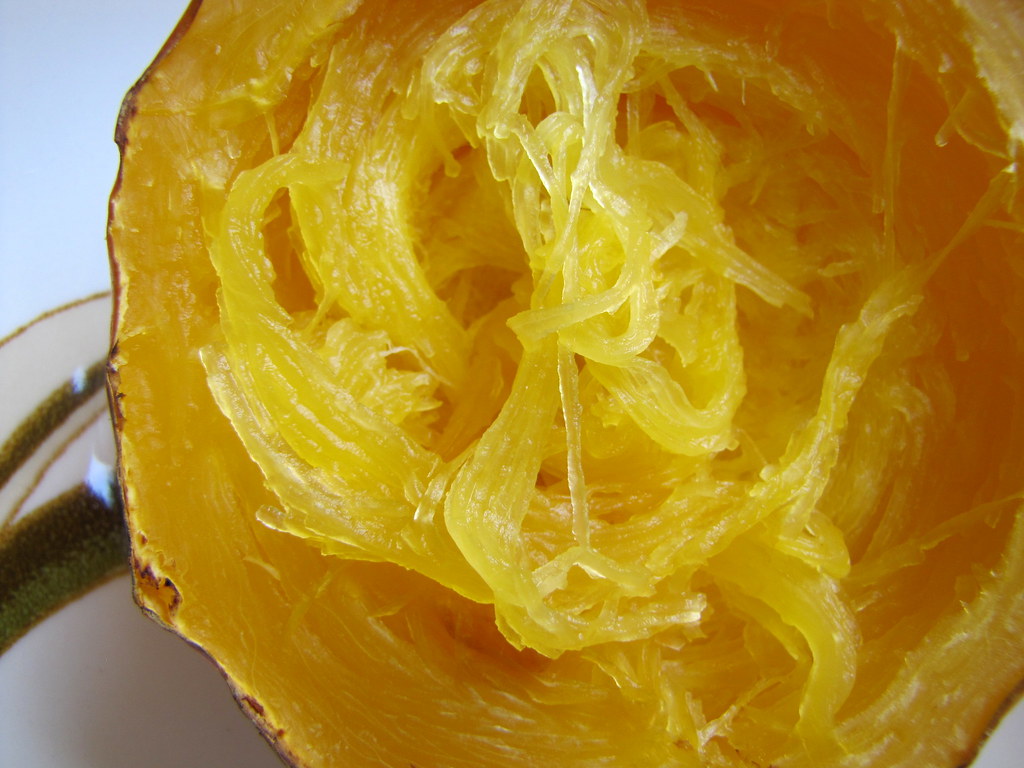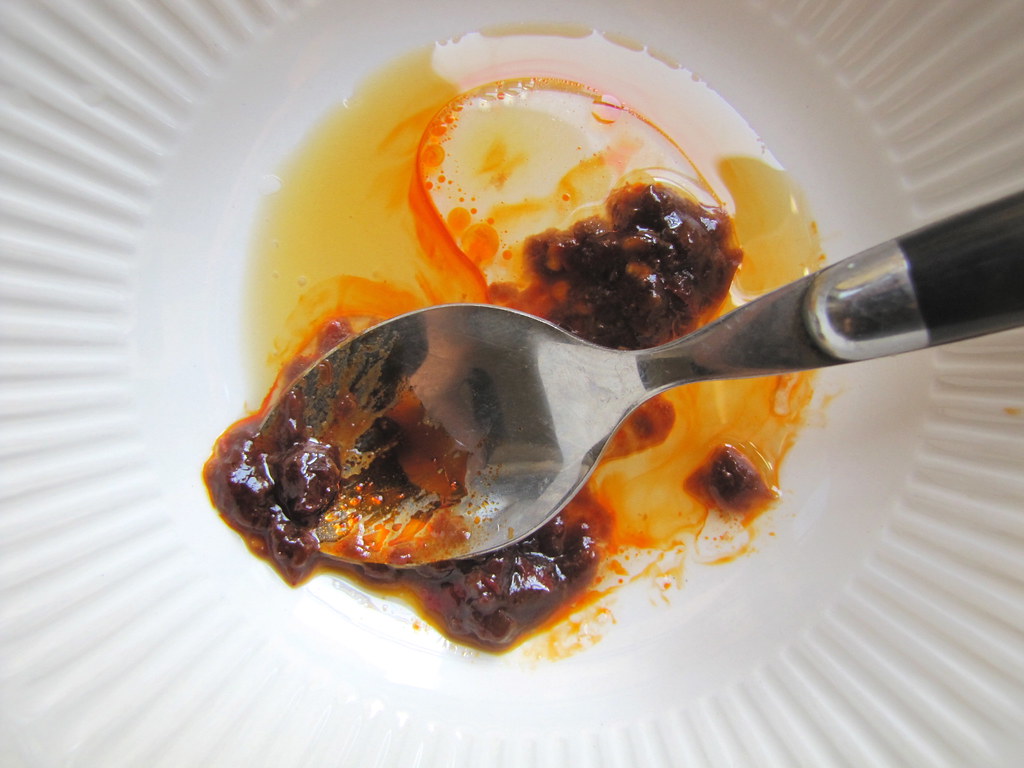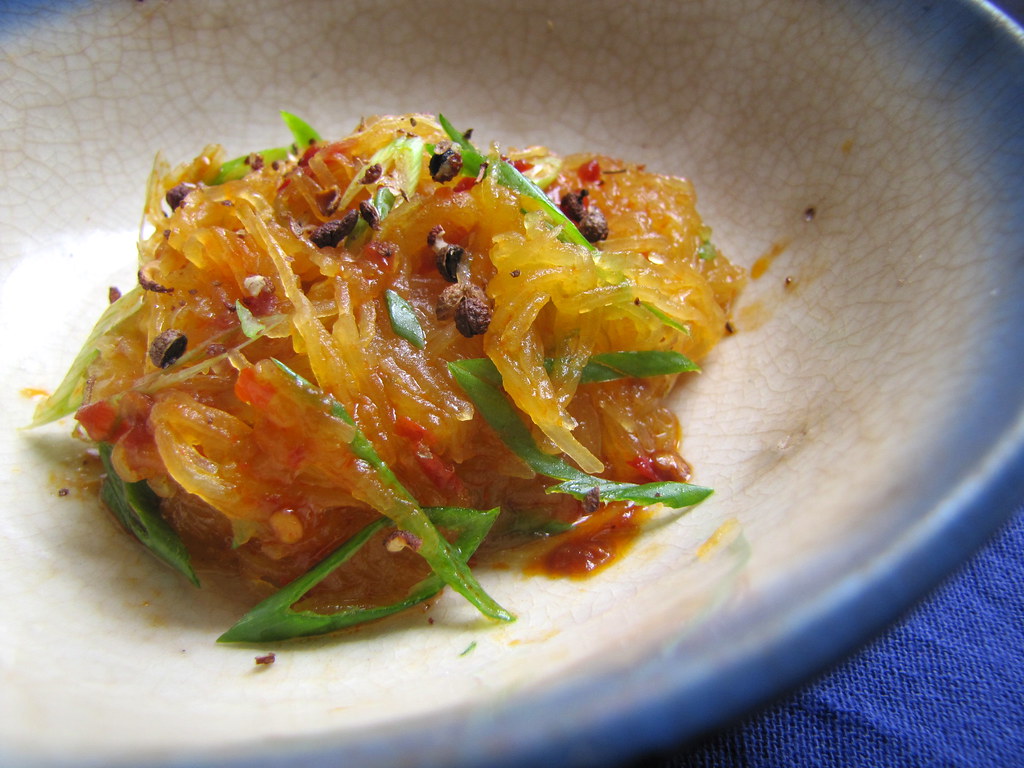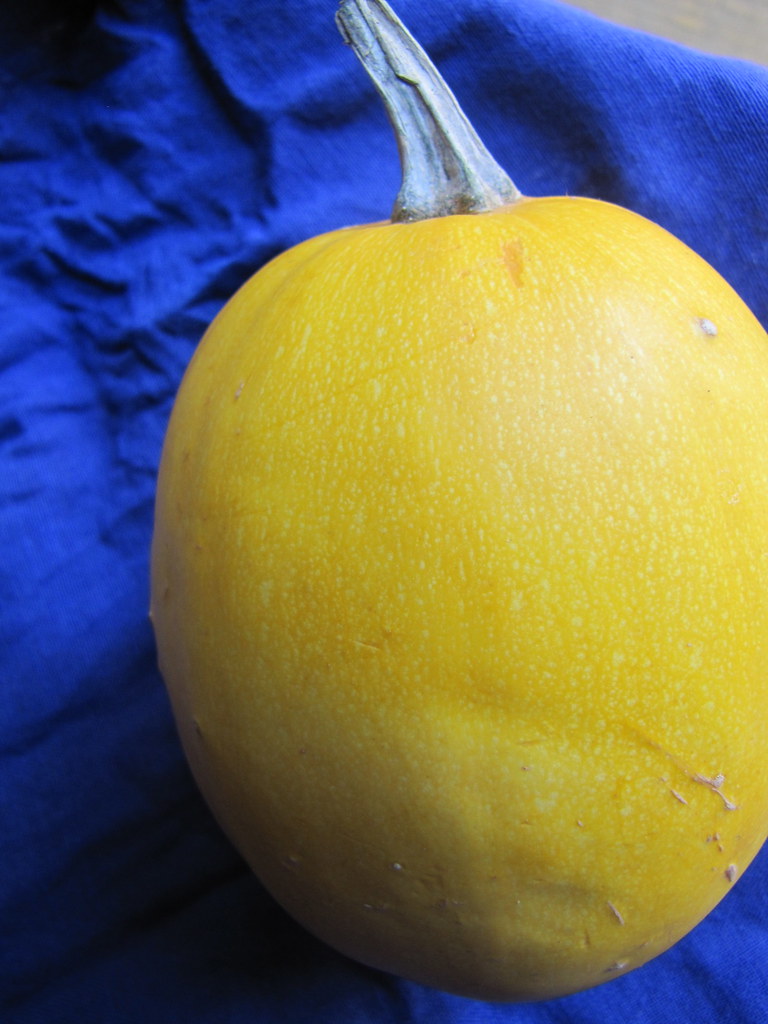There’s nothing like a good game of culinary caper. Here, the winter squash known for its strand-like striations once cooked has stolen the role of thin glass noodles in a Sichuan-style spicy dressing. The squash is orange, rather than glisteningly clear, but since it’s drenched in chili-laced oil and fermented bean paste, you might still mistake it for the former ingredient if you weren’t paying much attention. And then — yuk yuk yuk — bite into the salad, to find a hidden sweetness laying just underneath its vivid layers of flavor.
![]() So here’s one way to play up the natural nuances of spaghetti squash. Raw, it’s a vibrant, sunflower-yellow squash with a round to oblong shape, and tidy surface. Cooked, it tastes much like any other orange-fleshed winter squash (I can’t think of any that aren’t orange, come to think of it), and works great as such pureed into a soup. But that would be forfeiting its one attribute that sets it apart from the pack: that it separates into stringy pieces.
So here’s one way to play up the natural nuances of spaghetti squash. Raw, it’s a vibrant, sunflower-yellow squash with a round to oblong shape, and tidy surface. Cooked, it tastes much like any other orange-fleshed winter squash (I can’t think of any that aren’t orange, come to think of it), and works great as such pureed into a soup. But that would be forfeiting its one attribute that sets it apart from the pack: that it separates into stringy pieces.
You don’t want to mess with the spaghetti squash too much with a fork if you’re trying to keep these strands intact, I’ve learned. Therefore, I discovered that the best way to cleanly separate the interior, cooked flesh of spaghetti squash is with chopsticks. That led to my decision to toss it in — not marinara sauce — a tangy, Chinese chili sauce of sorts. My mom has this routine of bedtime snacking, where she boils some glass noodles (mung bean starch noodles, which usually come in stiff, birds’ nest-like bunches when dry) and drenches it with some soy sauce and fermented chili-bean sauce (doubanjiang), and maybe a fried egg to plop on top of it, too. Therein is a tasty, pantry staples-based snack or small meal. I don’t know that she’d ever recognize a winter squash as something to eat rather than decorate with around Halloween, but I doubt she’d notice the difference between these spaghetti squash “noodles” and her preferred type, especially during those midnight-snacking hours.
 after roasting face-down for 45 minutes
after roasting face-down for 45 minutes
 carefully peeling the spaghetti-like strands of flesh
carefully peeling the spaghetti-like strands of flesh
Sticking to my heritage, I kept things pretty simple and to a minimum when it came to whisking together a spicy cold noodle-appropriate sauce. Using spicy doubanjiang, often referred to on labels in English as “chili bean sauce” or “hot bean paste” as a base, I mixed up a little vinaigrette. This sauce makes an excellent all-purpose hot sauce if you’re bored with your old favorites, and it’s a must-have in the classic Sichuan dish, ma po tofu (and many other Chinese and Taiwanese dishes). It’s basically fermented fava beans, preserved with salt in a chunky mixture that often incorporates spicy chili peppers, as least for the last few centuries or so (since the pepper’s introduction to East Asia). Unlike the Japanese miso paste or the Korean gochujuang, it’s not pureed, so intact pieces of bean are likely floating about in it. You can find types that are oily, and some that are not. Some have more pureed beans with only chunky pieces of chilies about and others have whole fermented black beans in them instead. This is a large class of sauces, as you can presume, but the main point is that it’s intensely savory thanks to fermented beans, and spicy thanks to chili heat.
 chili bean paste dots a simple vinaigrette with sesame oil and rice vinegar
chili bean paste dots a simple vinaigrette with sesame oil and rice vinegar
Along with a dab of that stuff I stirred in some sesame oil and rice vinegar, and a splash of soy sauce and sprinkle of sugar. I wanted to bring out the natural sweetness of the spaghetti squash a bit more, and not totally squash it (pun intended) by the strong flavors otherwise. A thin coating of this sauce proved all that was needed to bring it to another level, and a dramatic turn of cuisines. I also tossed in some chopped scallions for a little color and fresh herbal kick — you could add cilantro instead, or along with. Finally, I sprinkled some crushed Sichuan peppercorns on top of the plated dish to give it a little more pizzazz. These aren’t necessary, and I don’t assume most people have a whole canister in their cupboards like I do, but the floral taste and signature, strange, numbing-hot effect of these peppercorns will really sate the appetite for Sichuan food, if that’s what you’re looking for.
Sweet and Numbing-Hot Spaghetti Squash Salad
(makes 3-4 servings)
roughly 2 lb spaghetti squash, halved and scooped and scraped from its seed pocket
1 tablespoon Chinese chili bean paste (doubanjiang)
1 teaspoon rice vinegar
1 teaspoon soy sauce
1/2 teaspoon sugar
1 tablespoon sesame oil
1-2 scallions, finely chopped
1 tablespoon Sichuan peppercorns, crushed (optional)
Preheat oven to 375 degrees. Place squash halves, once seed pockets have been scraped clean, flat side down on a lightly greased sheet tray. Bake for 40-50 minutes, or until the flesh is soft to the touch and the surfaces against the pan are slightly browned. Flip each half over and let cool for several minutes.
Mix the remaining ingredients besides the scallions and Sichuan peppercorns in a small bowl until the sugar is dissolved. Taste for seasoning, adding any more of each ingredient as desired.
Once cool enough to handle, gently peel apart the “spaghetti”-like strands from the inside of the squash. Place them in a bowl, and gently separate them by hand (you may find that poking them off the skin works best with chopsticks, then easing them into separate pieces into a bowl works best with your hands). Drizzle the dressing over the squash, and toss to coat evenly. Toss in the scallions. Serve with a sprinkle of crushed Sichuan peppercorn on each plate.
Cost Calculator
(for 3-4 servings)
2 lb spaghetti squash (at $1.50/lb): $3.00
2 scallions: $0.50
1 tablespoon chili bean sauce: $0.25
1 tablespoon sesame oil: $0.25
1 teaspoon each rice vinegar and sugar: $0.20
1 tablespoon Sichuan peppercorns: $0.25
Total: $4.45
Health Factor
![]()
![]()
![]()
![]()
Four brownie points: This is a side dish or small, tasty snack, not meant to fulfill all your nutrition for a meal. As such, it’s a tasty replacement for something much more rich — the extreme flavors from the spicy dressing will sate your tastebuds instead of caloric fats. By exploiting the natural sugars in winter squash, we use just a pinch of sugar in what could easily be a very sweet dressing, too.
Green Factor
![]()
![]()
![]()
![]()
![]()
![]()
Six maple leaves: I’ve been known to take a local, seasonal ingredient and dress it up with things that are not so before. But when you have an arsenal of dinner-ready sauces and condiments at your disposal (and that keep for an eternity in your fridge or pantry), it seems a great way to add some color and excitement to a lone ingredient from the dead of winter. I’d initially picked up the spaghetti squash at the Union Square Greenmarket telling its farmstand staff that it was “too pretty” not to; that’s a rare thing heard nowadays when the pickings are so slim for seasonal produce, and most of those choices are winter squashes and roots.

 spaghetti squash
spaghetti squash
5 Responses
Arthur in the Garden!
Love this recipe. I usually just put some butter and spices. This sauce look tasty!
Cat
Oh my mouth is watering–I am definitely going to try this!
Cat
I just made this and I’m not sure it’s going to survive the trip from the kitchen to the dining room. Yuuuuuum!
The Healthy Apple
This looks AMAZING, Cathy! Totally going to make this next week. Excited to see you on Friday!
Spicy spaghetti squash | Mojo Central
[…] recipe is a less-mouth-numbing variation of Cathy Erway’s Sweet and Numbing-hot Spaghetti Squash Salad, which (unlike my variation) uses raw […]